This article needs additional citations for verification .(May 2020) |
| NS Class 1700 | |||||||||||||||||||||||||||||
|---|---|---|---|---|---|---|---|---|---|---|---|---|---|---|---|---|---|---|---|---|---|---|---|---|---|---|---|---|---|
 1756 at Zwolle. | |||||||||||||||||||||||||||||
| |||||||||||||||||||||||||||||
| |||||||||||||||||||||||||||||
| |||||||||||||||||||||||||||||
| |||||||||||||||||||||||||||||

The Nederlandse Spoorwegen (NS) Class 1700 is a class of electric locomotives built by Alstom in 1990-1994.
Contents

This article needs additional citations for verification .(May 2020) |
| NS Class 1700 | |||||||||||||||||||||||||||||
|---|---|---|---|---|---|---|---|---|---|---|---|---|---|---|---|---|---|---|---|---|---|---|---|---|---|---|---|---|---|
 1756 at Zwolle. | |||||||||||||||||||||||||||||
| |||||||||||||||||||||||||||||
| |||||||||||||||||||||||||||||
| |||||||||||||||||||||||||||||
| |||||||||||||||||||||||||||||

The Nederlandse Spoorwegen (NS) Class 1700 is a class of electric locomotives built by Alstom in 1990-1994.

The Class 1700 locomotives were built by Alstom in 1990-1994. 81 of these locomotives, numbered 1701-1781, were built.
The Class 1600 was ordered in 1978, after several types of locomotives were tested in the 1970s. One of those was the French Class BB 7200, on which the 1600 is based. The 58 locomotives were delivered between 1981 and 1983. As a result of their delivery, the old Class 1000 and Class 1500 were taken out of service.
Thanks to the electronic power control, these locomotives were the most economical but also the most powerful locomotives that Dutch Railways had.
The Class 1700 are similar but not entirely equal to the Class 1600/1800. The newer 1700 series have updated and extended electronics, a newer safety system (ATB phase 4 vs ATB phase 3 in the 1600 series) and a different braking system. The locomotives are fitted with monomotor bogies.
Most visual difference between the 1700 and 16/1800 series is the automatic coupler on 1701-1728 subseries. These locomotives are used with NS DD-AR double-decker coaches in a push-pull setup and treated as an EMU. The couplers, from BSI (Bergische Stahl Industrie, Germany), allow a mechanical, pneumatic and electrical connection between two DD-AR sets. From the remaining 1729-1781 series a large number are converted to be used in push-pull sets with coaches from the rebuild ICRm series. Several of these coaches have been rebuilt with a drivers cab, allowing the loco to be remotely controlled. When not used in push-pull service, the loco is used in regular trains, available for maintenance or as reserve.
In 2012, many were put back in service with former nDDm double-decker cars and driving cars for Sprinter services. The carriages were withdrawn in 2018.[ citation needed ]
In 2010, the Dutch Railways took a few class 1700 out of service because there wasn't enough work for all locomotives. Number 1735 has been scrapped, due to a devastating fire, which occurred on 24 February 2000 in Venlo. Refurbishment was too expensive, so the loco was scrapped in 2002. Some locomotives carry names of towns and cities in the Netherlands, the table underneath shows which engines. [2]
|
|
|
This list of train routes in the Netherlands focuses on the routes taken by trains travelling on railway lines in the Netherlands. A list including all stops on the train routes can be found at Dutch railway services.
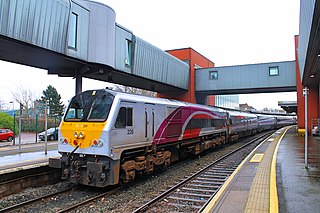
The Iarnród Éireann (IÉ) / Northern Ireland Railways 201 Class locomotives are the newest and most powerful diesel locomotives operating in Ireland and were built between 1994 and 1995 by General Motors Diesel. They are model type JT42HCW, fitted with an EMD 12-710G3B engine of 3,200 hp (2,400 kW), weigh 108.862 tonnes and have a maximum speed of 164 km/h (102 mph).
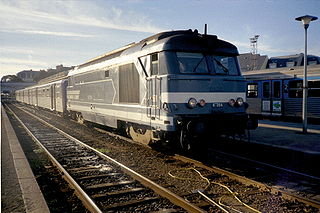
The Class BB 67300 is a group of diesel locomotives used by SNCF. They were built by Brissonneau and Lotz between 1967 and 1969.
Push–pull is a configuration for locomotive-hauled trains, allowing them to be driven from either end of the train, whether having a locomotive at each end or not.

The NS Class 1600 is a type of B′B′ electric locomotive built by Alstom between 1980 and 1983 based on the SNCF Class BB 7200, and in use by the Dutch Railways since 1981. They were styled by the French industrial designer Paul Arzens.
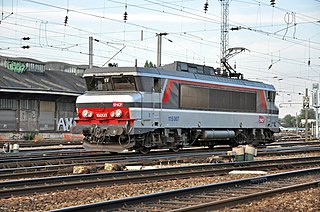
The SNCF class BB 15000 is a class of 25 kV 50 Hz electric locomotives built by Alstom and MTE between 1971 and 1978. Initially 65 locomotives strong, the class was widely deployed on the whole French 25 kV network before being replaced by TGV trains when the LGV Est went into service in 2007.

The SNCF Class BB 7200 is a 1.5 kV DC electric locomotive operated by the SNCF in France. It is the DC version of the 'Nez Cassé' family of locomotives built between 1976 and 1985 by Alstom. They are rated for 4,040 kW (5,420 hp) of continuous power. SNCF Class BB 15000 is the AC version while the Class BB 22200 is a dual-voltage version. Another relative is the NS Class 1600 operated in the Netherlands, a DC locomotive based on the BB 7200. Intended primarily for passenger service, increasing numbers are being allocated for freight service with lower-geared bogies as passenger services are taken from locomotive-hauled coaches by TGV services. BB 7200 operations are limited to the French 1.5 kV DC electrified network in southeastern France, from Paris southwards. In 2016 48 were allocated to freight, 58 to intercity passenger service, 50 to regional passenger service, and two to auto-train service.

The Double-deck Coach is a bilevel passenger railcar currently manufactured by Alstom, which acquired Bombardier Transportation in 2021 used by various European railways and Israel Railways. The current generation of double-deck coaches can be run at speeds up to 200 km/h (125 mph). Depending on their configuration, each coach can seat 100 to 150 passengers.
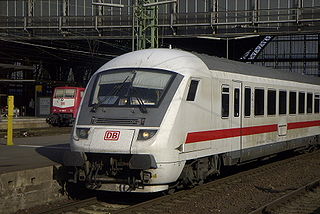
A control car, cab car, control trailer, or driving trailer is a non-powered rail vehicle from which a train can be operated. As dedicated vehicles or regular passenger cars, they have one or two driver compartments with all the controls and gauges required to remotely operate the locomotive, including exterior locomotive equipment such as horns, bells, ploughs, and lights. They also have communications and safety systems such as GSM-R or European Train Control System (ETCS). Control cars enable push-pull operation when located on the end of a train opposite its locomotive by allowing the train to reverse direction at a terminus without moving the locomotive or turning the train around.
The DD class (later reclassified into D1, D2 and D3 subclasses) was a passenger and mixed traffic steam locomotive that ran on Victorian Railways from 1902 to 1974. Originally introduced on mainline express passenger services, they were quickly superseded by the much larger A2 class and were relegated to secondary and branch line passenger and goods service, where they gave excellent service for the next fifty years. The DD design was adapted into a 4-6-2T tank locomotive for suburban passenger use, the DDE (later D4) class. They were the most numerous locomotive class on the VR, with a total of 261 DD and 58 locomotives built.

Class 11 is part of the large 1980s family of 144 electric locomotives. The family was made up of Classes 11 (12), 12 (12), 21 (60) and 27 (60). Classes 11, 12 and 21 were nearly twice as powerful as Classes 22, 23 and 25 while Class 27 was more than twice as powerful as these 1950s locomotives. This family was heavily influenced by the Class 20² from the mid-1970s. They were very reliable because of the trial and error development of their predecessor. This family came into service with M4 and M5 coaching stock and the AM 80 and AM 86 series of EMUs. This generation was a major modernization of the NMBS/SNCB even if the older M2 coaching stock remained active for more than a decade before being replaced. The only real difference between a Class 11 and a Class 21 was the Class 11 had a transformer inside to allow working under both 3000 V DC in Belgium and 1500 V DC plus Dutch signalling and train protection for working in Holland. Externally they were identical to Classes 12 and 21 aside from the livery and a few minor details.
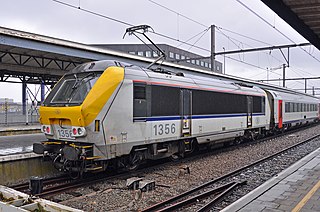
The Class 13 are a type of mixed use 200 km/h (124 mph) multivoltage electric locomotive of type Traxis designed by Alstom in the late 1990s for the Belgian and Luxembourgish railways.

Class 25 locomotives were part of the 1950s generation of SNCB electric locomotives that included Types 122, 123, 125, and 140 built between 1953 and 1961. There were 50 Series 122, 83 Series 123, 16 Series 125 and 6 Series 140 for a total of 155 locomotives. They were seen across Belgium on passenger and freight trains until they were retired in 2012. Class 23 was later fitted for multiple working, and were often found in pairs. There was no difference in power between the classes as they all used the same traction motors and control equipment.

SNCB Class 25.5 locomotives were part of the 1950s generation of SNCB electric locomotives that included Series 122, 123, 125, and 140 built between 1953 and 1961. There were 50 Series 122, 83 Series 123, 16 Series 125 and 6 Series 140 for a total of 155 locomotives. They were seen across Belgium on passenger and freight trains until they were retired in 2012. There was no difference in power between the classes as they all used the same traction motors and control equipment.

The Class 1100 locomotives of Nederlandse Spoorwegen were a class of 1,500 V DC Bo′Bo′ electric locomotives, introduced from 1950. They were built by Alsthom to an original design of the French BB 8100. They operated in the Netherlands.

These DB Class V 100 diesel locomotives were produced in the late 1950s by the Deutsche Bundesbahn for non-electrified branch lines as a replacement for steam locomotives. The V 100 class was built in three different variants.

NS DDZ were built by Waggonfabrik Talbot, De Dietrich Ferroviaire and Adtranz between 1992 and 1998 and are operated in the Netherlands by Nederlandse Spoorwegen (NS). This class is a type of a power concentrated electric multiple unit and was delivered in two batches as DDM-2 and DDM-3. A trailer cars of this multiple unit can also be operated with a Class 1700 electric locomotive instead of a motor car, forming a push-pull train.

The Indian locomotive class WAG-12B is a class of 25 kV AC electric locomotives that was developed in 2017 by Alstom with technological collaboration with Indian Railways. The model name stands for wide gauge(W), Alternating Current (A), Goods traffic (G) locomotive-12 . They entered trial service in 2019. A total of 370 WAG-12B have been built at Electric Locomotive Factory, Madhepura, Bihar, India.

The NS 1700 was a series of express steam locomotives of Nederlandse Spoorwegen and its predecessor Maatschappij tot Exploitatie van Staatsspoorwegen (SS).